#which that's fine. psychonauts is about raz after all i find him funny and i wonder what horrendous truths will he discover more if there is
Explore tagged Tumblr posts
Text
I think they are supposed to be twins???
(maybe originally in the concept art, but in canon it seems they aren't anymore? dion has been stated to be the oldest, but my thoughts are maybe like he's the older twin lmao. i will probably be 100% wrong if there is ever a future installment in this series.)

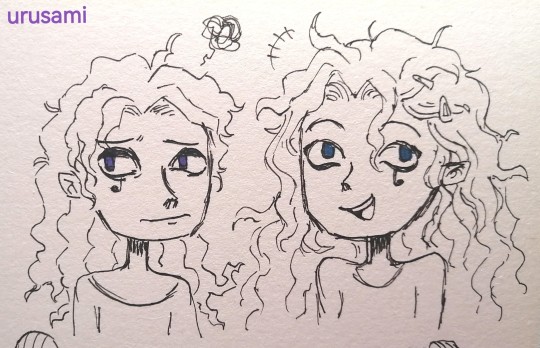
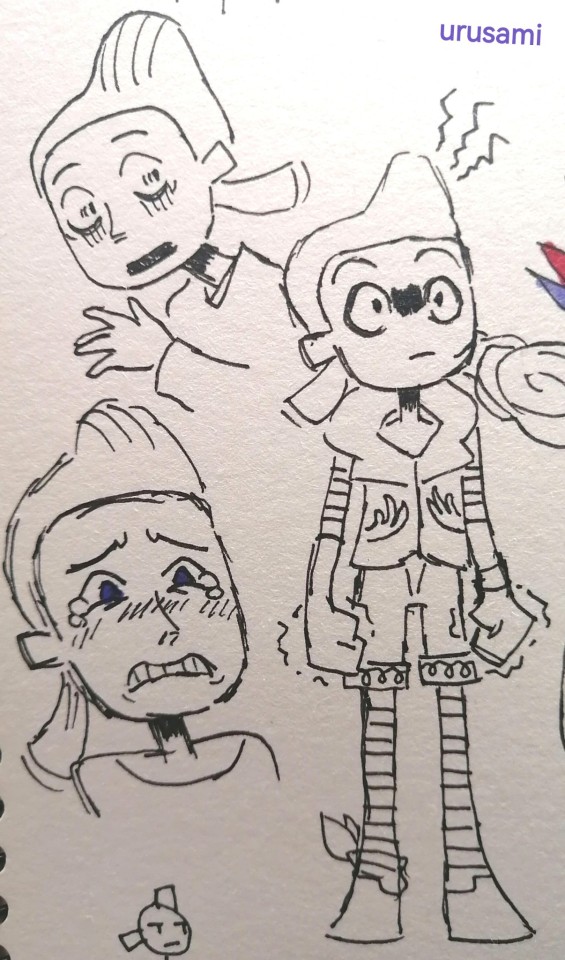
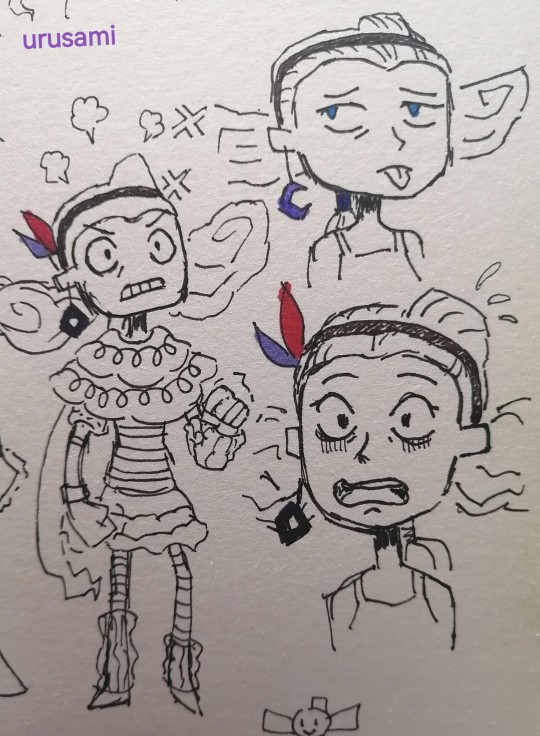
Funny story, I originally wanted to color these sketches, but I found that most of my traditional art supplies are unusable (the pencil colors has a very faded color, and most of my markers have a diluted yellow coloring lmaoooo ToT). I haven't been using them from 2019 and it really shows.
Oh yeah, here's a full page sketch.
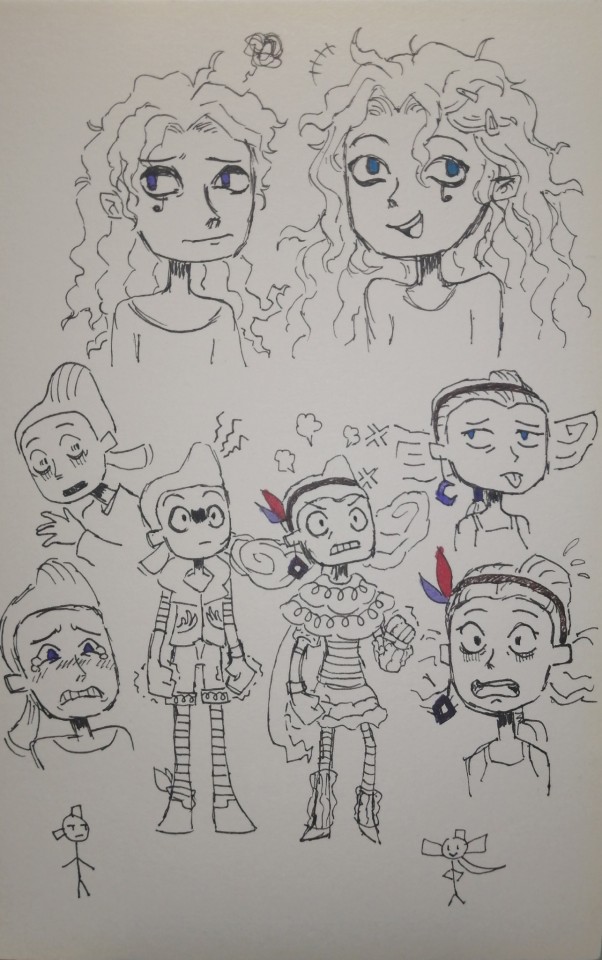
#psychonauts 2#psychonauts dion#psychonauts frazie#dion aquato#frazie aquato#psychonauts#traditional art#sketches#unfinished art#pen sketches#art#fanart#cartoon fanart#double fine productions#fanart 2025#usagifuyusummerart2025#you can find more of my ramblings on these guys in the alt text lmao i yap a lot i know#i love these guys but there's not much discussion going on about them especially dion since they're not really the focus on the second game#which that's fine. psychonauts is about raz after all i find him funny and i wonder what horrendous truths will he discover more if there is#ever a future game. unrelated but i love razzle dazzle's was it? AU of Dion not being psychic really? but he can see ghosts#(and the side abilities that come with that) which i think is a passive psychic ability. not strong like what the rest of their family#members have but it does align with what i think his character is like. dismissive but he does care he just can't show it because nobody#will believe him something like that. i have more to blab on this but tag limit lmao#this is just me relieving stress btw i'll get back on track when i feel more better.#you'll see me posting random stuff when i can't focus on what i want to do lol.#plus i've been thinking maybe my un-banger posts should have a specific tag? tundra or cold post??? i'll think about it....#if you read all of this then wow thank you hope you have a nice day wherever you are
48 notes
·
View notes
Note
you got any funky intern headcanons?
Hoooo boy, DO I???? I'm going to be honest though, this one needed a little time to stew in the brain juices!
Alright, I'm starting with Adam, as he is my favorite. The first I have for him is I think, a pretty popular one, which is that he has a little sibling around Razputin's age. That one's just precious to me. but also I think he was quite similar to Raz at that age himself, which is why he's nicer to him than the other interns right off the bat.
also, I think his family is a pretty important psychic family, hence the fact that he's really knowledgeable about all this stuff and also a little bit...stuck up. (said with love!) so I imagine he's been coming to the states for Psychonauts stuff pretty frequently since he was little. I also like to think that the Natividads are similarly well-known in the psychic world, and he and Lizzie clicked as little kids after hanging out at those and have been best friends ever since. (Norma did NOT hang out with them because she's Too Mature and Definitely Not Lonely, Lizzie, I Know Dad Sent You To Check On Me But I'm Fine.)
I kinda have one overrunning headcanon for Norma and Lizzie here, which is stemming off a line where I believe Norma references her "parents," plural (or so it says on the wiki? I can't actually remember this one) but also one of Lizzie's lines in the endless cycle of drinks is "how about a Hazy Regret? that was my mom's favorite" so my thoughts on this is that Lizzie and Norma's mom passed away years ago, but that their dad got remarried. Norma gets along with her stepmother--Lizzie does NOT.
(also I think Norma is, yeah, kinda lonely. She doesn't have many friends, and in turn because of that she's meaner to other people, and it's a whole awful cycle. not that that excuses how much of an asshole she was to an actual ten year old child!!! I just think she's got to work through some stuff.)
(ALSO also, on the subject of the Lady Luctopus bar lines and circling back to Adam here, the "Dad's Shame" line is because Lizzie, for absolutely no identifiable reason, doesn't like Adam's dad--and he's not actually a bad dad or anything, he just gets on Lizzie's nerves for reasons even Adam doesn't know. He finds it funny.)
Gisu! I have to say, Gisu isn't inspiring me right now for some reason. But I imagine she'd be a handful to deal with in school. Like, she's really smart, but also she doesn't have a whole lot of respect for authority and has probably got in trouble a couple times for getting in random arguments with teachers. I think maybe she wasn't part of the Psychonauts programs until pretty soon before the games, but she finds she really is much more in her element there and ends up putting most of her focus into psychic science.
wait wait wait I DO have something about Gisu. she is very much a hopeless, sappy romantic. you wouldn't expect it, but she's a movie crier as well. and you know how I said in my Aquato headcanon post that Dion cries when Nona reads sad books aloud to the family (and then denies it to anyone who asks)? yeah, a very early date between the two is watching a sad movie and it goes about as well as anyone would expect.
Morris, on the other hand, has known the Psychonauts for a really long time--specifically, Milla! I don't know how common in the Psychonauts universe psychic powers as a disability aid are, but as Morris seems to be pretty close to Milla by the time pn2 begins, I think it'd be sweet if when Morris started showing his powers when he was little, his parents got in contact with the Psychonauts so he could perfect his levitation and Milla, of course, was the one who came. Milla being Milla, she was nice and friendly and all and he thought she was The Coolest Ever and she ended up becoming a long term family friend.
And also, Morris at some point gets his hands on a record of Boney M's "Rasputin." KLOB has a field day with that one.
Last but certainly not least, Sam! I firmly believe that Sam is the youngest of the interns before Raz got there. Like, I imagine the interns are all high school aged (again with the exception of Raz), but Sam is, like, the only freshman. Hence the "I'm not a baby" "yeah you are," lines when Raz first meets the interns. I think that's why she's a little more isolated from the rest of the interns--you rarely see her, like, actually talk to any of her peers in the game. She's by herself at pretty much any given point in the physical world (except when she's talking to Oleander, but he's not her peer), comes into the final battle by herself, the only time you really see her with another person is when she's with Gisu in Hollis' Hot Streak. Even then, I don't think Gisu really talks to her--she's more doing her own thing (losing!!! by following her foolish heart!!!) and Sam is just...there. But also Sam doesn't seem lonely, I think she might be just more of the type of person who does her own thing.
also!!!! on Dogen's campster page, it says, "I didn't want to wear the hat but they [his family] said I had to and that when I got to camp there would be plenty of kids wearing special hats." so yeah my mental image with that is Dogen being like "are you sure the other kids won't make fun of my hat?" and Sam is like "no way!!! foil hats are, like, the biggest trend with psychic kids nowadays!!!" look she's a good big sister and anyone can feel free to fight on this one
(count the amount of times I said "also" in this post because my ADHD brain wouldn't know 'succinct' if it hit her in the face! also I had to ask Siri to spell succinct for me! It has more c's and less s's than I wanted it to.)
#psychonauts#adam joseph gette#lizzie natividad#norma natividad#gisu nerumen#morris martinez#sam boole
22 notes
·
View notes
Text
ok i have SO many thoughts about the game. consider this a messy ramble review about the game (spoilers ahead)
ok so gameplay wise. i really enjoy the game- lots of improvements but also! very very similar formula to the last game. when i realized that i was afraid it would feel too similar and boring, like the collection of the psychic 6 felt thorny towers-esque BUT it all came together in a very different way with much different dynamics at play. all the minds were so interesting and while really big, they weren’t so hard to move through and the changes of scenery in many definitely kept it all interesting.
concept wise- with minds and things. all the minds were real interesting- i like some more than others of course. but they all displayed some kinda metaphor that was pretty easy to grasp and i think thats important! as always i appreciate how the game tackles symptoms and ideas and not specifically named disorders. for one it means it wont be dated, but it also means anyone can find ways to relate regardless of labels. i think metaphor wise, bob’s was my favorite... that was a rough one. look wise? probably nona’s mind. just so colorful!
on dated terms, retcons. i cant be the only one seeing retcons right? which is fine and good really. i think this game was a chance for them to backtrack and alter some old ideas. its been 16 years.... theres no way in hell whatever was in mind back then is true or good now. Ford’s mind situation was handle VERY well. as someone with DID i like ford, but it seemed clear to be they needed to tackle this as a psychonaut lore thing and not “multiple personality disorder with a twist” ya know? and it totally worked out. it made sense in his context and my god, so much more painful to see how it happened. it makes sense that a story would be told “wrong” in order to cover things up- it confused me at first as i noticed the retcons but as the theme of the story unravelled into that of distrust, it made sense. additionally of course the use of the g slur and raz’s curse. well, the twist-retcon really got me!! i didnt expect it and i think with the other elements of ford’s story it was a good way to handle it! post game, frazie mentions the galochios (which up to then hadnt been mentioned) where they call them “fortune tellers”. so yeah, they definitely changed that. and making a twist that took focus off the “galochios” as a whole was a good move.
on the story...... stated above a bit but man, so many twists i didnt see coming. lots of theories we had were very wrong probably because it was not based around the assumption that some things would be kinda.. retconned. and it was written in such a way it was a fun surprise. i can imagine some being upset but the writing in this game was just great. i feel they expanded on the lore and characters so well! in the start of the game i was quite shocked by the event of raz changing Hollis’ mind tbh, and we werent even that far into the game for me to be surprised by that. this game feels like it had much high stakes, which makes sense with such a large threat and now being more settled in this world with these characters. to go from raz doing something impulsive and distrusting to then having his own hero torn down in front of him because ford basically manipulated his family into living lies..... yeah, thats harsh. i do wish some more focus was on raz’s anger, i dont feel like he got a chance to be that angry at ford before they helped nona but, the connection raz makes with her was so heartfelt, it did help support that development. additionally this game carries the same sort T rated humor as the first, and i love that. it allows for a more serious angle and harder topics to flourish which still being quite funny. all in all i really liked the story, and while it feels quite conclusive, i dont really mind. i know id love to have a third game but its hard to imagine that happening.
and man. the little details! so much dialogue i need to hear on replays! i will be 100%ing the game too of course. and i love how they handled the curse post game, having raz be caught and supported by the water... was wondering how you’d play post game after that.
15 notes
·
View notes
Text
Hi guys! In this post, I will tell you why I find the relationship between Dr. Loboto and Coach Oldeander very interesting. And no, it's not just because they worked together in the first game that I find it interesting. I have many other reasons that I will mention. This analysis will also have spoilers related to Psychonauts 2 so don't read if you don't want to be spoiled... Let's go!
First I'm going to talk about the similarities between them two:
• They have the same voice actor who is none other than Nick Jameson. This one also makes the voice of Mr. Pokeylope in the first game and the Psychonauts Operator in Rhombus of Ruin. And I find it just great. Their voices are so different. Loboto's voice is high, while Oleander's is low. Nick Jameson is really talented and I think it's great.
• Loboto is blue and Oleander is orange. And we all know that blue and orange are complementary colors.
• Loboto is tall and Oleander is small. This honestly goes well together in terms of "partner in crime".
• They both have a scar on their face.
• Loboto lost his right arm and Oleander lost sight of his right eye.
• They both wanted to be a sailor. In Rhombus of Ruin, we can see that Loboto clearly wanted to be one. Part of his mind is a giant bathtub with a boat and in this boat there is First Mate Loboto who is none other than a sailor. When he was a child, he literally wore a sailor outfit. And he did a lot of experiments on fish. Linda in the first game and all the fish guards in the midquel game. All this is related to the marine world. And his skin is just blue as the sea. Just saying.
Oleander talks about the Navy a lot. So much so that in Rhombus of Ruin, he is very happy when he has a mermaid tail and says he would like the Navy to see him now. Being a sailor would certainly have been his dream job but alas, he was too short. And he also can’t swim because of his stumpy legs.
• They both have a problem with their parents. (But who doesn’t in the Psychonauts world, honestly?) Loboto's parents outright lobotomized their son just because he was psychic and Oleander's father slaughtered his precious little bunny right in from of him. These events are truly tragic.
• The Whispering Rock Pamphlet. Oleander wrote this pamphlet. And this pamphlet says "You were born with a special gift. But the people around you treat it like a curse. Your mother is afraid of you, and your father looks at you with shame in his eyes." And it makes me think so much of Loboto. Because that's what happened to him. His mother was afraid of him and his father most certainly looked at him with shame in his eyes. And Oleander wrote that. And in my opinion, it seems very personal. Oleander's family surely saw him too this way. And so it's a big point in common between Loboto and him.
• They are both at least into men. Let me explain.
In Rhombus of Ruin, we learn that Oleander likes the boy band "All Paul". Three male mermaids singing love songs. And he's a big fan of them. He even sings one of their songs which is “Drag Me Down”. The fish guards draw each characters during the game. And they drew Oleander with the members of All Paul with hearts all around them. As you can see in the picture below.
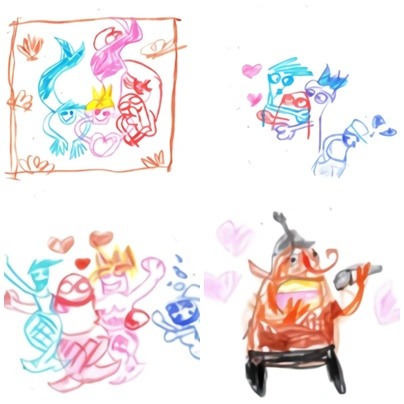
In Psychonauts 2, there is a small detail that we can miss if we are not careful. But in his mind, there are a lot of posters and one of them shows two male teeth in love. And the elements of an individual's mind say a lot about his personality.
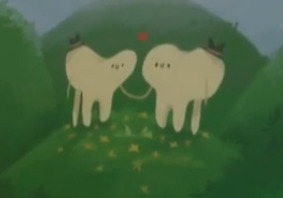
So, Oleander and Loboto are either gay or bi. And it’s wonderful to think about it.
• The song Drag Me Down. This song is sung by Oleander but did you know that this song is also found on Loboto's computer in his laboratory in the Rhombus? It would mean that Loboto is a fan of All Paul too and it's fun to think about it. It's also a song about a breakup. In my opinion, this could be related to the fact that Oleander and Loboto no longer work together. If we analyze few lyrics from it, it can really be about them. “ When we met it was the best thing that I've known “, “I gave you everything you asked” (Reference to Loboto giving Linda to Oleander?) and “Never worried it wouldn't last but we are”. Oleander probably never worried that it could end but alas... A turtle named Pokeylope decided otherwise by blasting his partner. A tragic and true story.
• They both like to dance. Loboto always takes those little dance steps that we see in the first game and Ror, when he turns on himself. And Oleander dances when he sings "Drag Me Down", proving that he likes it as well.
• Raz saw them both when they were young children in their minds. Also, the first level in Psychonauts is Oleander’s mind and the first level in Psychonauts 2 is Loboto’s mind.
That’s all about the similarities, now I’m going to talk about the three games.
Psychonauts:
• In the first game, they worked together and they had a lot of fun together.
Just... Look at them.



They are just completely evil together. Partners in crime, after all.
• Loboto was very excited about taking over the world, too. In this cutscene where we see him talking with Lili we can clearly see his excitement over this. So, Loboto also wanted to be a part of it. Imagine, if he and Oleander had succeeded... The world will be complete chaos! Full of teeth and brains!
Rhombus of Ruin:
Although they do not interact in the midquel game, there are still some crisp info.
• Loboto talks about Oleander saying he has "a touch of halitosis". Halitosis is bad breath. Given their size difference, how does he know? Loboto is like... Twice Oleander’s height as you can see in the picture below.
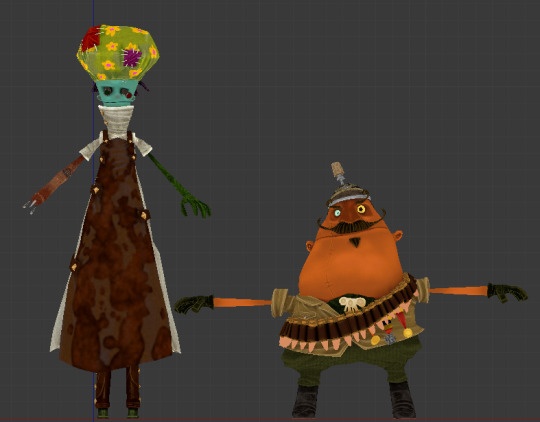
To be realistic, I think that since Loboto is a dentist he most certainly wanted to check the condition of Oleander's teeth and realized that it was a complete mess. Or maybe he kissed him and that’s how he knew.
• Loboto will say that he doesn't want this "little fellow" (Oleander) to learn about his new client. He thinks he wouldn’t like to know he was moonlighting. Why does Loboto care about it? Suspicious.
• If you don’t enter his mind at immediately, Loboto begins to speak by himself by saying dialogues of events he has experienced from the past. And he talks a lot about Oleander. He says: “That army man... What was he thinking? Psychoblaster Death Tanks?” and he laughs. But his laugh is natural, it’s not an usual crazy laugh like he always do. He also says: “Are you trying to impress girls... OR TAKE OVER THE WORLD? And you do NOT want to know what kind of gas mileage those things got.” which is... very funny to me.
• Oleander is the one who will come with his psycho-portal to give it to Raz. So in a way we can say that it is thanks to Oleander that Loboto has his moral compass back.
Psychonauts 2:
We don't know a lot about the game yet but a demo was released last summer, in June 2019, I absolutely love it. Loboto and Oleander interacted in it.
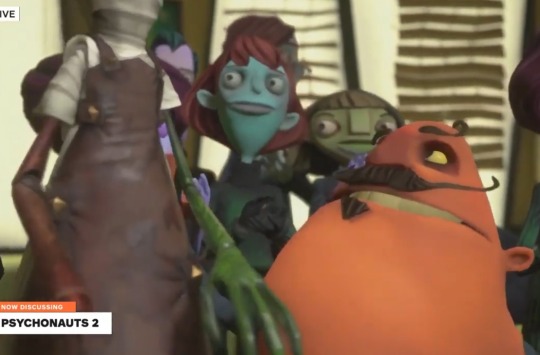
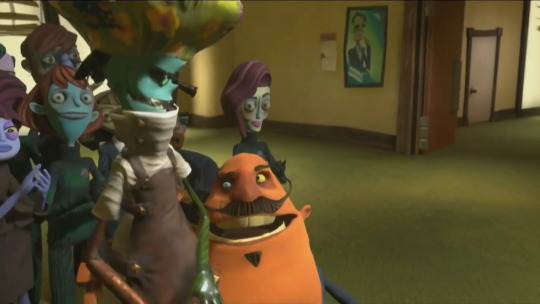
• As you can see in the pictures above, Oleander put his arm around Loboto. (Did he touch his butt?!) And he is very friendly towards him. I know they're supposed to be "acting" for Loboto to reveal who his boss is. But let's agree... Oleander is way too friendly with him.
• Oleander calls Loboto "Cal", not even Caligosto or Loboto like the others do. He calls him by a nickname. First name basis is a very friendly thing.

• He says to Loboto that he is going to love that vacation package and that he’s jealous. And then he looks at him and his eyes shine. I honestly think he’s the one who make this little package, by the way. He also looks very proud of him.
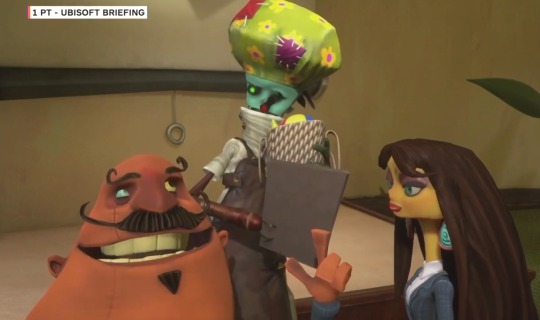
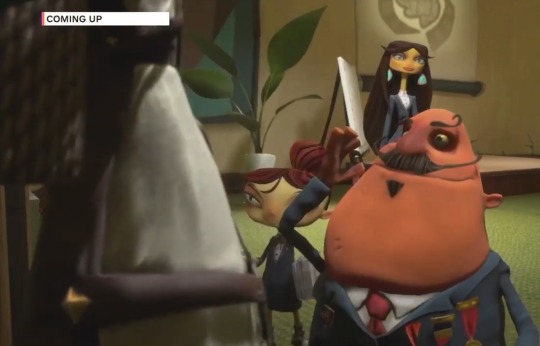
• He also says “Maybe he doesn’t want those tropical vacations after all!” and “Hurry up or I”ll take those vacations myself!” he teased him at least twice.
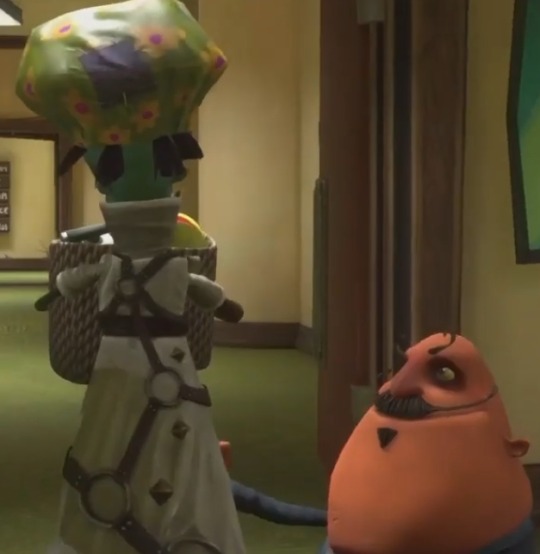
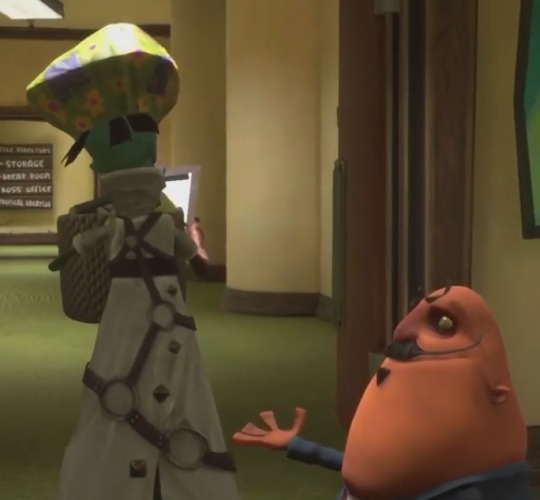
• And he acts very “gentlemanly” toward him. Just look at the pictures above.
Oleander is a true, a real... GENTLEMAN! A man of good manner, I see.
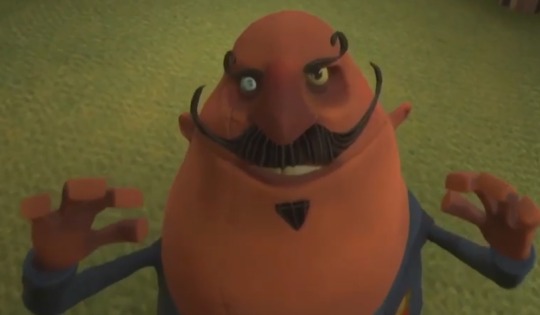
• Bonus: Loboto vision. Oleander is... SO SMALL!
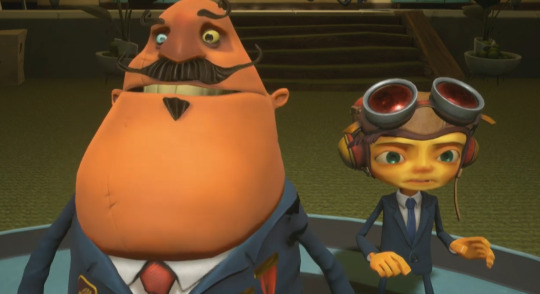

• In another scene, Oleander and Raz face a censor. Oleander begins to explain to Raz what a censor is and what they do, everything seems to be fine until he gets to the "Don't belong" part. Oleander realizes this and displays a sad face. He even looks at the ground, for a second, in silence as if he was thinking of something. Maybe he feels sad because Loboto doesn't see him as a friend but a threat and that's why he looks so... thoughtful.
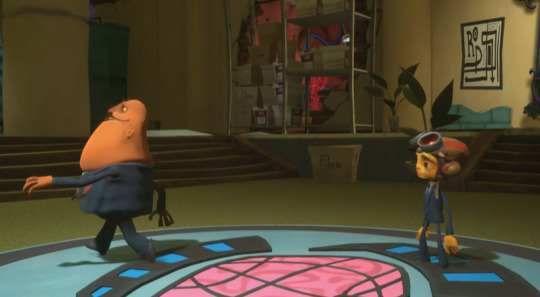
• In this same scene, he begins to flee. (Colliding with a chair, by the way) He is certainly fleeing because he does not want the censor to expel him. Leaving Raz to take care of all the work.

Name a better duo than Oleander and this chair, I’ll wait.
That’s all about the games. Now mind if I share two... Headcanons?
Headcanons:
• I think Loboto and Oleander are the same age and that they were born in the 50s. Which would mean they lived their childhood in the 60s.
Let's talk about their parents.
First of all, Oleander’s dad.
When I did my research, I wanted to find out what a butcher looked like in the 60s and this is the image I found.

Pretty similar clothes to the ones Oleander’s dad wears.
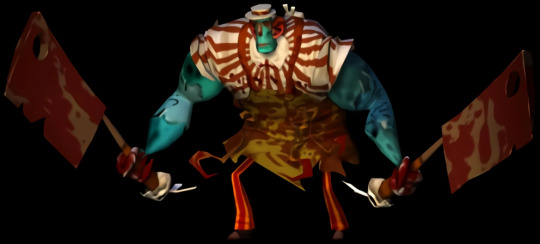
See? It honestly looks very similar.
Now let’s talk about Loboto’s parents and especially about his mom.
Image below is how dresses looked in the 60s.

And this is Loboto’s mom:
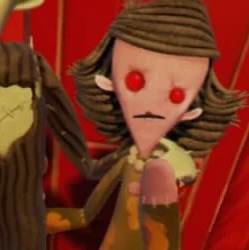
It’s the same kind of dress...
...So, Loboto’s parents and Oleander’s dad are from the same time.
And by "time", I mean the 60s.
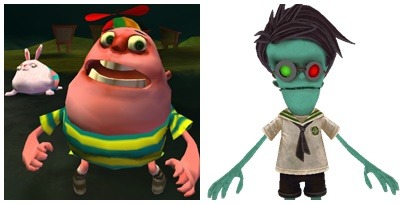
Even the clothes Oleander and Loboto wore when they were kids, have 60s vibes, in my opinion... So! This would mean they’re the same age or around the same age. If we assume that the events of Psychonauts are in 2003, it would mean that in the events of the games, they are either in their early 40, or in their mid-40. Even late 40 or early 50 if they were born before 1955.
• My second headcanon is that I think they know each others for years. The legend of the monster in the lake (Linda) is apparently very old. And we all know who made Linda looking this way. It was Loboto. So, it would mean that Loboto and Oleander have worked on that for a very looooooooooong time. That would also explain why Oleander calls Loboto “Cal” in the PN2 demo. Because they were friends since a very long time. Maybe they even knew each others before that. Could be honestly cute if they were childhood friends, to be honest.
...Well! That’s all about my analysis. Their relationship sure is interesting and if you’ve read the whole thing then... Thank you! I wonder what will happen to them exactly in the second game. I could see them being a team again honestly. They fit so well together and not especially in the romantic way. I think that they could be a great team. Maybe they will both win the employee of the year award in Psychonauts 2 and going to tropical vacations together? Maybe even they will explore the world instead of taking over it? We’ll see!
95 notes
·
View notes
Text
How a joke about the milkman inspired Psychonauts' best level – PC Gamer
The Milkman Conspiracy started, as many great things do, in a Thai restaurant. Or maybe it didn’t. Tim Schafer can’t remember exactly. Somebody—perhaps him—came up with the phrase ‘I am the milkman, my milk is delicious’, and it may or may not have been during a Double Fine team meal. “I wish someone had said it at the restaurant, because their milk was delicious,” he says.
Either way, those eight words unified ideas that had been buzzing around his head for a conspiracy theory-themed Psychonauts level. It’s how most levels for the zany platformer started: Schafer brought the concept, the artists re-imagined it, the designers dreamt up the gameplay, and then the world builders and programmers brought it to life. So how did The Milkman Conspiracy go from a simple, silly phrase to one of the most beloved levels in a beloved game?
How did The Milkman Conspiracy go from a simple, silly phrase to one of the most beloved levels in a beloved game?
Schafer has always been fascinated by people who genuinely believed conspiracy theories, and wanted to know what was going on inside their heads. “I loved the movie Capricorn One when I was a kid, on faking the moon landing. Just the idea that someone would think [it was true] was so funny to me, in the same way some people think flat earthers are funny now, but I find it very sad, because it’s just a symptom of how scary and misleading the internet can be,” he says.
He drew up a chart of conspiracies and linked them all to a central character, Boyd. Some of the theories were famous, or taken from movies. Some were inspired by office chats, others by a homeless man named Doug, who lived on the streets nearby. “We’d pay him $10 a week to sweep our driveway,” Schafer says. “He had ups and downs. Certain days he thought the government was trying to do things with him, and some days he didn’t. It was interesting to talk to him… trying to get inside of his head was very inspirational for the level. I still see him around the neighbourhood.”
Psychonauts was an exercise in dealing with mental illness in a comic way—the team were conscious of never “punching down” and wanted players to empathise with the characters, Schafer says. For Boyd, that meant showing the problems he’d been wrestling with: Being fired from a string of jobs and having an alter-ego implanted in his mind by Psychonauts villain Oleander.
That alter-ego was, of course, the Milkman.
Image 1 of 5
(Image credit: Double Fine)
Image 2 of 5
(Image credit: Double Fine)
Image 3 of 5
(Image credit: Double Fine)
Image 4 of 5
(Image credit: Double Fine)
Image 5 of 5
(Image credit: Double Fine)
Visually, Schafer imagined Boyd’s mind world as a giant spider’s web, with Boyd’s house at the centre. He also wanted it to give it a retro, ’50s spy vibe, and thought a suburban neighborhood would be the perfect setting: Relatively mundane on the surface, but hiding a dark secret. He gave the concept to his artists.
Art director Scott Campbell tells me he wanted to emphasise paranoia, and he drew eyes and binoculars popping out of trashcans, mailboxes and bushes to make the player feel like they were being watched. He also came up with the G-Men, who kept an eye out for suspicious activities.
“I based their outfits on the classic ’50s G-Men detectives in their overcoats and hats, reminiscent of the Spy vs Spy comics in Mad magazine and every single TV show from that time period,” he says. “I just loved that spies always wore those overcoats and people were supposed to not notice them in hotel lobbies or on park benches with their newspapers covering their faces, with just their eyes showing.”
Campbell says the team found it funny to simply give the G-Men a single object as a disguise, and have them act out what was clearly the wrong use for that object. It’s why you see G-Men using red stop signs to hammer in imaginary nails, or playing a bouquet of flowers like a guitar, and it’s the root of much of the level’s humour.
Schafer recalls the initial magic of the level coming from a drawing by concept artist Peter Chan. “Suburbia is supposed to look mundane, but what if it was all just vaulted up against the sky? He had this drawing of the roads bent and twisted in the air, like [Boyd’s] thinking was twisting back on itself and illogical.
“And I was like, ‘woah’, the programmers were like, ‘woah’.”
Image 1 of 4
(Image credit: Double Fine)
Image 2 of 4
(Image credit: Double Fine)
Image 3 of 4
(Image credit: Double Fine)
Image 4 of 4
(Image credit: Double Fine)
Schafer knew instantly that was the road to pursue, but he still had no idea what the gameplay would look like, so he brought in lead designer Erik Robson. Up until that point in the game, the team hadn’t used the player’s inventory much, and Robson was keen on an adventure game-style level where players combined items in their inventories to solve puzzles.
Those puzzles would be themed around the G-Men guarding certain areas, and the players would have to carry the right item to blend in. It fit well with Clairvoyance, a psychic power that let protagonist Raz see through the eyes of other characters, which had come from Schafer’s research into psychic abilities.
The trick, Robson tells me, was to make every possible item and Clairvoyance interaction entertaining, including failures. The team knew players would try to combine seemingly unconnected items, or try out their powers on inanimate objects, so they created a huge spreadsheet of every possible interaction, filling each box with a new idea.
“We know we have to have something fun for if I use the clairvoyance on the feather I’m holding, for example,” he says, “We knew those interactions would all be possible… it ends up being a situation where a bunch of creative people have to brainstorm and come up with fun solutions, and hopefully, that ends up being entertaining for a player.”
Sometimes those interactions would be simple: When used on a keypad, Raz is seen as a giant finger. But others would require more time and effort, and one of the brilliant things about Double Fine was that three designers were allowed to take three days to come up with the right concept.
Image 1 of 10
(Image credit: Double Fine)
Image 2 of 10
(Image credit: Double Fine)
Image 3 of 10
(Image credit: Double Fine)
Image 4 of 10
(Image credit: Double Fine)
Image 5 of 10
(Image credit: Double Fine)
Image 6 of 10
(Image credit: Double Fine)
Image 7 of 10
(Image credit: Double Fine)
Image 8 of 10
(Image credit: Double Fine)
Image 9 of 10
(Image credit: Double Fine)
Image 10 of 10
(Image credit: Double Fine)
All the things that seem like antagonists, in the level, are… like an immune system trying to understand an alien body in its midst.
Designer Erik Robson
The Milkman Conspiracy ended up much larger than originally planned, partly because of the team’s relative gravity tech. The programmers came up with a way to flip gravity as you moved between the twisted, spiralling streets that Chan had drawn, and the camera would react in kind. It worked brilliantly, and the level naturally expanded as Robson took players off in different directions.
The sprawling design also fit into the theme, he says. “Broadly, the goal of every Psychonauts mind level was to express the personality of the character in whatever way possible. I think there was something appealing about it being an open-air maze. That’s a weird contradiction that seems consistent with Boyd: ‘I’m lost, but I can see everything. I see my goals, but I can’t suss out how I’m going to get there.'”
In the end, Robson feels Milkman sprawled too much. “There’s maybe two or three of those ambient houses when there should really only be one. As a level designer, my proclivity is to make things too big, so there might be a bit of guilt kicking in there.”
Robson also wishes the team could’ve better expressed Boyd’s inner turmoil throughout the level. The opening sequence, where the player uses Clairvoyance on Boyd and sees the conspiratorial scrawls he’s made on the walls of his house, is an example of when it worked, because it gave the player a sense of what was to come while revealing something about Boyd’s character, Robson says.
“All the things that seem like antagonists, in the level, are… like an immune system trying to understand an alien body in its midst. And that alien body is the what the Milkman represents, this thing that is there and buried, but he can’t get rid of, and he knows something bad is going to happen as a result. There are a bunch of things I think we did get, the sort of confusion and how nothing is quite what it seems, the open-air maze. But I think that would have been cool to kind of drive that emotional point home better.”
[embedded content]
Partly because of these niggles, Robson says he’s never thought of Milkman as a standout level. But he says it’s one of the funniest, and Schafer’s writing undoubtedly brings the whole thing together. Simply written down, the jokes—”The most pleasant sewers can be found in Paris, France”—have almost zero impact. But their deadpan delivery works so well in the context of the level, and the ultra-serious G-Men talking about how “rhubarb is a controversial pie flavor” as they try hopelessly to blend in with their given roles proves to be hilarious.
That was only possible because writing all the dialogue came last. After the designers and gameplay programmers had finished, Schafer would assess every piece of the level, and write dialogue based on all the work that came before. “That was the most solid foundation for the jokes to get layered on top,” Robson says. “Half of my memory of Milkman is playing it without any of that dialogue, so that stuff still almost feels like a sort of recent edition. And then after you’re done with the level, six or eight weeks later, this dialogue appears all of a sudden in the game.”
Schafer tells me he wanted Erik Wolpaw to write the dialogue, but Wolpaw ended up being too busy. “So I ended up writing all the G-Men dialogue myself and I’m so happy I did, because it was so fun,” he says. “It’s just that matter of fact, straight-laced: ‘Who was the milkman? What was the purpose of the goggles?’
“We just happened to be talking about pie a lot, about people thinking rhubarb can be dangerous if you cook it wrong. You can poison people. So it’s a very controversial variety of pie—being able to sneak stuff like that in was really fun. It was really relaxing to write in that flat tone. ‘My helicopter goes up and down.'”
It’s those jokes that I, and many other players, remember best about The Milkman Conspiracy. But for Double Fine, it carries its own legacy: a reminder that “no one person makes a level”, Schafer says. “I didn’t think of the twisting roads, and I didn’t think of the way the G-Men functioned. But I still feel like the ideas that I cared about are in there, and each department got to contribute an essential part of the level. Any one piece of that, you took it away, and it’s not the same,” he says.
(Image credit: Double Fine)
Let’s block ads! (Why?)
Source link
Bài viết How a joke about the milkman inspired Psychonauts' best level – PC Gamer đã xuất hiện đầu tiên vào ngày Funface.
from Funface https://funface.net/best-jokes/how-a-joke-about-the-milkman-inspired-psychonauts-best-level-pc-gamer/
1 note
·
View note
Text
How a joke about the milkman inspired Psychonauts' best level – PC Gamer
The Milkman Conspiracy started, as many great things do, in a Thai restaurant. Or maybe it didn’t. Tim Schafer can’t remember exactly. Somebody—perhaps him—came up with the phrase ‘I am the milkman, my milk is delicious’, and it may or may not have been during a Double Fine team meal. “I wish someone had said it at the restaurant, because their milk was delicious,” he says.
Either way, those eight words unified ideas that had been buzzing around his head for a conspiracy theory-themed Psychonauts level. It’s how most levels for the zany platformer started: Schafer brought the concept, the artists re-imagined it, the designers dreamt up the gameplay, and then the world builders and programmers brought it to life. So how did The Milkman Conspiracy go from a simple, silly phrase to one of the most beloved levels in a beloved game?
How did The Milkman Conspiracy go from a simple, silly phrase to one of the most beloved levels in a beloved game?
Schafer has always been fascinated by people who genuinely believed conspiracy theories, and wanted to know what was going on inside their heads. “I loved the movie Capricorn One when I was a kid, on faking the moon landing. Just the idea that someone would think [it was true] was so funny to me, in the same way some people think flat earthers are funny now, but I find it very sad, because it’s just a symptom of how scary and misleading the internet can be,” he says.
He drew up a chart of conspiracies and linked them all to a central character, Boyd. Some of the theories were famous, or taken from movies. Some were inspired by office chats, others by a homeless man named Doug, who lived on the streets nearby. “We’d pay him $10 a week to sweep our driveway,” Schafer says. “He had ups and downs. Certain days he thought the government was trying to do things with him, and some days he didn’t. It was interesting to talk to him… trying to get inside of his head was very inspirational for the level. I still see him around the neighbourhood.”
Psychonauts was an exercise in dealing with mental illness in a comic way—the team were conscious of never “punching down” and wanted players to empathise with the characters, Schafer says. For Boyd, that meant showing the problems he’d been wrestling with: Being fired from a string of jobs and having an alter-ego implanted in his mind by Psychonauts villain Oleander.
That alter-ego was, of course, the Milkman.
Image 1 of 5
(Image credit: Double Fine)
Image 2 of 5
(Image credit: Double Fine)
Image 3 of 5
(Image credit: Double Fine)
Image 4 of 5
(Image credit: Double Fine)
Image 5 of 5
(Image credit: Double Fine)
Visually, Schafer imagined Boyd’s mind world as a giant spider’s web, with Boyd’s house at the centre. He also wanted it to give it a retro, ’50s spy vibe, and thought a suburban neighborhood would be the perfect setting: Relatively mundane on the surface, but hiding a dark secret. He gave the concept to his artists.
Art director Scott Campbell tells me he wanted to emphasise paranoia, and he drew eyes and binoculars popping out of trashcans, mailboxes and bushes to make the player feel like they were being watched. He also came up with the G-Men, who kept an eye out for suspicious activities.
“I based their outfits on the classic ’50s G-Men detectives in their overcoats and hats, reminiscent of the Spy vs Spy comics in Mad magazine and every single TV show from that time period,” he says. “I just loved that spies always wore those overcoats and people were supposed to not notice them in hotel lobbies or on park benches with their newspapers covering their faces, with just their eyes showing.”
Campbell says the team found it funny to simply give the G-Men a single object as a disguise, and have them act out what was clearly the wrong use for that object. It’s why you see G-Men using red stop signs to hammer in imaginary nails, or playing a bouquet of flowers like a guitar, and it’s the root of much of the level’s humour.
Schafer recalls the initial magic of the level coming from a drawing by concept artist Peter Chan. “Suburbia is supposed to look mundane, but what if it was all just vaulted up against the sky? He had this drawing of the roads bent and twisted in the air, like [Boyd’s] thinking was twisting back on itself and illogical.
“And I was like, ‘woah’, the programmers were like, ‘woah’.”
Image 1 of 4
(Image credit: Double Fine)
Image 2 of 4
(Image credit: Double Fine)
Image 3 of 4
(Image credit: Double Fine)
Image 4 of 4
(Image credit: Double Fine)
Schafer knew instantly that was the road to pursue, but he still had no idea what the gameplay would look like, so he brought in lead designer Erik Robson. Up until that point in the game, the team hadn’t used the player’s inventory much, and Robson was keen on an adventure game-style level where players combined items in their inventories to solve puzzles.
Those puzzles would be themed around the G-Men guarding certain areas, and the players would have to carry the right item to blend in. It fit well with Clairvoyance, a psychic power that let protagonist Raz see through the eyes of other characters, which had come from Schafer’s research into psychic abilities.
The trick, Robson tells me, was to make every possible item and Clairvoyance interaction entertaining, including failures. The team knew players would try to combine seemingly unconnected items, or try out their powers on inanimate objects, so they created a huge spreadsheet of every possible interaction, filling each box with a new idea.
“We know we have to have something fun for if I use the clairvoyance on the feather I’m holding, for example,” he says, “We knew those interactions would all be possible… it ends up being a situation where a bunch of creative people have to brainstorm and come up with fun solutions, and hopefully, that ends up being entertaining for a player.”
Sometimes those interactions would be simple: When used on a keypad, Raz is seen as a giant finger. But others would require more time and effort, and one of the brilliant things about Double Fine was that three designers were allowed to take three days to come up with the right concept.
Image 1 of 10
(Image credit: Double Fine)
Image 2 of 10
(Image credit: Double Fine)
Image 3 of 10
(Image credit: Double Fine)
Image 4 of 10
(Image credit: Double Fine)
Image 5 of 10
(Image credit: Double Fine)
Image 6 of 10
(Image credit: Double Fine)
Image 7 of 10
(Image credit: Double Fine)
Image 8 of 10
(Image credit: Double Fine)
Image 9 of 10
(Image credit: Double Fine)
Image 10 of 10
(Image credit: Double Fine)
All the things that seem like antagonists, in the level, are… like an immune system trying to understand an alien body in its midst.
Designer Erik Robson
The Milkman Conspiracy ended up much larger than originally planned, partly because of the team’s relative gravity tech. The programmers came up with a way to flip gravity as you moved between the twisted, spiralling streets that Chan had drawn, and the camera would react in kind. It worked brilliantly, and the level naturally expanded as Robson took players off in different directions.
The sprawling design also fit into the theme, he says. “Broadly, the goal of every Psychonauts mind level was to express the personality of the character in whatever way possible. I think there was something appealing about it being an open-air maze. That’s a weird contradiction that seems consistent with Boyd: ‘I’m lost, but I can see everything. I see my goals, but I can’t suss out how I’m going to get there.'”
In the end, Robson feels Milkman sprawled too much. “There’s maybe two or three of those ambient houses when there should really only be one. As a level designer, my proclivity is to make things too big, so there might be a bit of guilt kicking in there.”
Robson also wishes the team could’ve better expressed Boyd’s inner turmoil throughout the level. The opening sequence, where the player uses Clairvoyance on Boyd and sees the conspiratorial scrawls he’s made on the walls of his house, is an example of when it worked, because it gave the player a sense of what was to come while revealing something about Boyd’s character, Robson says.
“All the things that seem like antagonists, in the level, are… like an immune system trying to understand an alien body in its midst. And that alien body is the what the Milkman represents, this thing that is there and buried, but he can’t get rid of, and he knows something bad is going to happen as a result. There are a bunch of things I think we did get, the sort of confusion and how nothing is quite what it seems, the open-air maze. But I think that would have been cool to kind of drive that emotional point home better.”
[embedded content]
Partly because of these niggles, Robson says he’s never thought of Milkman as a standout level. But he says it’s one of the funniest, and Schafer’s writing undoubtedly brings the whole thing together. Simply written down, the jokes—”The most pleasant sewers can be found in Paris, France”—have almost zero impact. But their deadpan delivery works so well in the context of the level, and the ultra-serious G-Men talking about how “rhubarb is a controversial pie flavor” as they try hopelessly to blend in with their given roles proves to be hilarious.
That was only possible because writing all the dialogue came last. After the designers and gameplay programmers had finished, Schafer would assess every piece of the level, and write dialogue based on all the work that came before. “That was the most solid foundation for the jokes to get layered on top,” Robson says. “Half of my memory of Milkman is playing it without any of that dialogue, so that stuff still almost feels like a sort of recent edition. And then after you’re done with the level, six or eight weeks later, this dialogue appears all of a sudden in the game.”
Schafer tells me he wanted Erik Wolpaw to write the dialogue, but Wolpaw ended up being too busy. “So I ended up writing all the G-Men dialogue myself and I’m so happy I did, because it was so fun,” he says. “It’s just that matter of fact, straight-laced: ‘Who was the milkman? What was the purpose of the goggles?’
“We just happened to be talking about pie a lot, about people thinking rhubarb can be dangerous if you cook it wrong. You can poison people. So it’s a very controversial variety of pie—being able to sneak stuff like that in was really fun. It was really relaxing to write in that flat tone. ‘My helicopter goes up and down.'”
It’s those jokes that I, and many other players, remember best about The Milkman Conspiracy. But for Double Fine, it carries its own legacy: a reminder that “no one person makes a level”, Schafer says. “I didn’t think of the twisting roads, and I didn’t think of the way the G-Men functioned. But I still feel like the ideas that I cared about are in there, and each department got to contribute an essential part of the level. Any one piece of that, you took it away, and it’s not the same,” he says.
(Image credit: Double Fine)
Let’s block ads! (Why?)
Source link
Bài viết How a joke about the milkman inspired Psychonauts' best level – PC Gamer đã xuất hiện đầu tiên vào ngày Funface.
from Funface https://funface.net/best-jokes/how-a-joke-about-the-milkman-inspired-psychonauts-best-level-pc-gamer/
0 notes